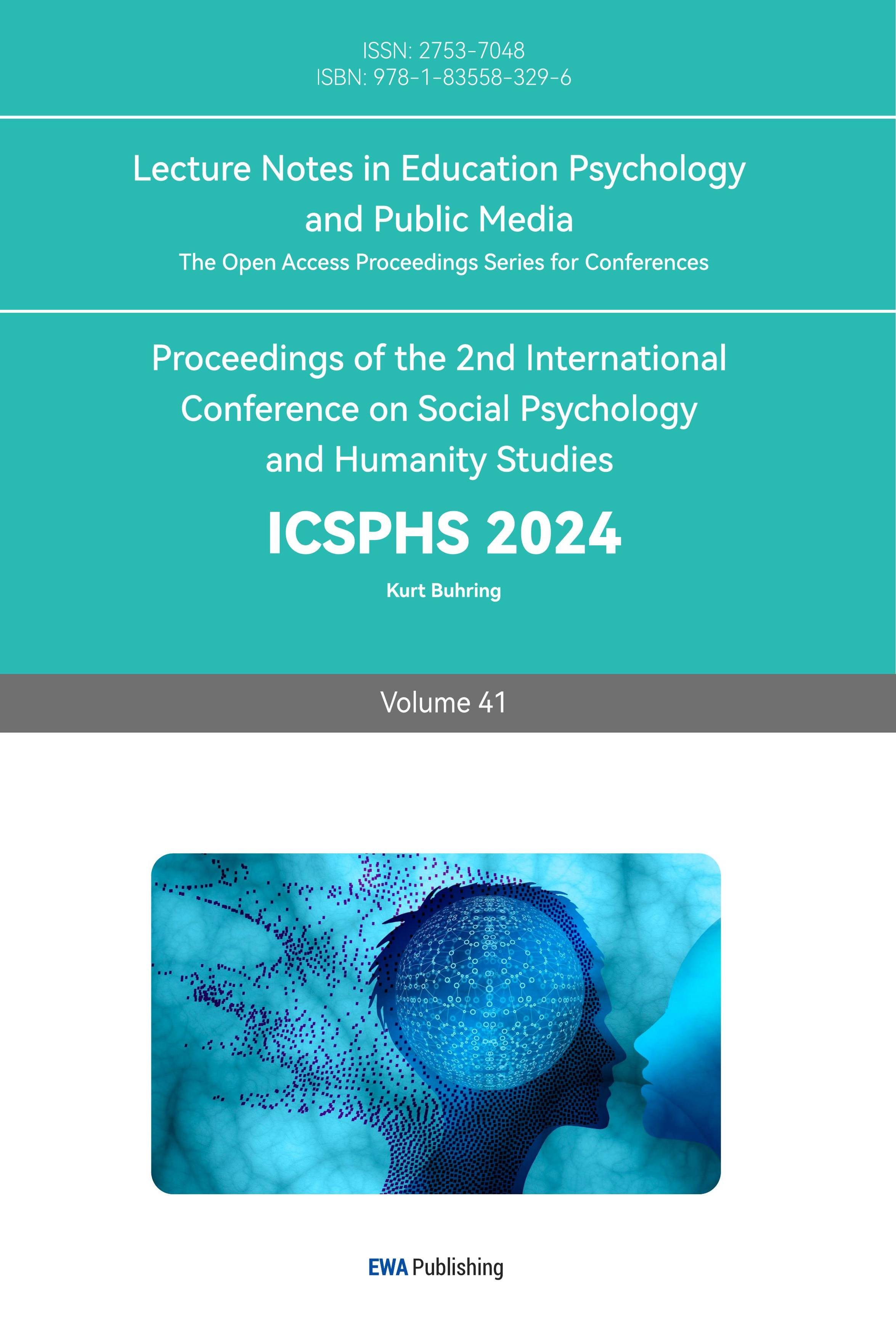1. Introduction
Currently, China is in the process of establishing a housing security system primarily centered around public rental housing, guaranteed rental housing, and mutual property right housing. In October 2022, the "Twentieth National Congress" report reiterated the commitment to the principle that houses are for living, not for speculation. It emphasized the need to accelerate the establishment of a housing system characterized by multi-entity supply, multi-channel security, and a combination of renting and purchasing. Against the backdrop of significant national housing system reforms, China's housing security system is continually improving, and the residential nature of housing is gradually being restored. In 2009, the Xuhui District and Minhang District in Shanghai took the lead in the trial operation of mutual property right housing, marking a development history of 14 years to date. Mutual property right housing targets the "sandwich class" facing housing difficulties, which includes those who do not qualify for affordable or economically applicable housing but lack the financial capability to purchase on the market. Another category includes those who meet the criteria for other forms of secured housing but have specific requirements for housing quality or wish to share property rights with the government based on a certain contribution ratio [1]. Mutual property right housing possesses dual characteristics of property ownership and secured housing, providing a good guarantee for addressing housing challenges for the sandwich class and meeting the housing needs of urban low- to middle-income families and groups such as new university graduates [2]. In comparison to other forms of secured housing, mutual property right housing offers property-based secured housing, providing a wealth appreciation avenue for the financially capable sandwich class. Once they accumulate sufficient income and possess the capability to pay, they can apply for full property ownership, thereby achieving a higher quality of life [3].
As of 2022, Shanghai has constructed 105,969 units of mutual property right housing in seven districts, including Pudong, Minhang, Songjiang, Qingpu, Jiading, Baoshan, and Fengxian, representing a significant scale. From the perspective of layout suitability, the existing mutual property right housing in Shanghai faces challenges in the planning and layout process, mainly including issues of remote location, spatial clustering, and inadequate public service facilities. Firstly, the rationality of site planning is insufficient, resulting in lower land transfer benefits for mutual property right housing. The locations often tend to be in underdeveloped urban fringe areas, yet the target beneficiaries largely rely on employment opportunities provided by the city center and surrounding supporting public services. This leads to spatial mismatches, causing problems such as separation of work and residence and spatial mismatch that affect the satisfaction of the beneficiaries and have implications for housing prices and other socio-economic development aspects. Secondly, concentrated construction of mutual property right housing leads to the aggregation of low-income populations, potentially causing social stratification and residential segregation, exacerbating wealth disparities. Finally, the inadequate allocation of resources has resulted in underdeveloped supporting public service facilities for already constructed secured housing, causing inconvenience in residents' transportation and access to public facilities. Therefore, it is imperative to conduct in-depth research on the accessibility of public facilities and the suitability of spatial distribution for mutual property right housing in Shanghai. This study aims to propose rational and effective site selection and construction planning recommendations to enhance the overall housing security system in Shanghai.
This paper takes into consideration the factors that urban low- to middle-income individuals pay close attention to when choosing the location of secured housing. These factors are used as specific indicators for assessing the suitability of the spatial layout of mutual property right housing. Using ArcGIS software, the current spatial distribution status of mutual property right housing in Shanghai is analyzed, focusing on the spatial accessibility of surrounding public facilities and distribution suitability. The objective is to provide reasonable spatial distribution recommendations for mutual property right housing construction in Shanghai and other cities. This includes optimizing the allocation of various urban resources, enhancing resident satisfaction, and promoting the sustainable, healthy, and stable development of affordable housing construction in China.
2. Literature Review
Research on the suitability of spatial distribution for affordable housing in foreign countries began early, with studies focusing on factors influencing, accessibility, and construction models. Holloway et al. found that public housing projects exacerbated poverty concentration, leading to resource mismatches and social class stratification [4]. Atkinson argued that most irrational public housing projects concentrated large numbers of low-income individuals spatially, fostering regional effects that contributed to social exclusion [5]. Teitz proposed the theory of public facility location, emphasizing the need for comprehensive consideration of welfare equity and efficiency in facility layout [6]. Timothy, through random sampling of affordable housing in the United States, discovered unfair distribution in housing transportation connectivity and accessibility. He proposed developing near highly connected transportation hubs to increase the supply of affordable housing and equitably distribute resources [7]. ZHONG et al. established an optimal site selection model for affordable housing to enhance public transportation accessibility for low-income workers. This aims to reduce spatial clustering, improve employment accessibility, and increase social benefits [8]. Keith et al. conducted a survey on elementary schools in Florida and found that an increasing number of low-income families' students attended schools characterized by high poverty concentration. Providing affordable housing in middle to high-income communities had a significant positive impact on impoverished children attending these schools [9].
In China, research on the spatial distribution suitability of affordable housing is still in the exploratory stage. Zheng Siqi et al. found that local governments, relying on "land finance," increased the allocation of land for commercial housing while squeezing the land for affordable housing. This is a major cause of the remote location and overly concentrated construction of affordable housing [10]. DANG et al. studied the distribution of affordable housing in Beijing and found that, with local housing demand and social demographics unchanged, areas with higher land prices, a higher proportion of old housing, and stronger subway accessibility had a lower probability of affordable housing development [11]. Zhu Wenjian et al. empirically analyzed the spatial distribution relationship between affordable housing and subway stations in Shenzhen. They discovered significant differences between administrative regions, and an imbalanced distribution of affordable housing projects along subway lines [12]. The irrational spatial layout of affordable housing in China promotes spatial agglomeration and residential spatial differentiation among low-income urban populations, ultimately leading to the marginalization of their social status [13].
Foreign countries introduced mutual property right housing in 1980, starting with the UK, and later developed in the United States, Singapore, Japan, and other nations. They have conducted in-depth discussions on the issues in the development process of public housing. In contrast, China piloted mutual property right housing in 2007 in Huai'an City, Jiangsu Province. In recent years, it has gradually explored a housing security system suitable for China's national conditions. Early research is no longer applicable to the current rapid development of major cities, and there are differences in economic development, infrastructure construction, and other aspects among various cities.
3. Spatial Layout Analysis of Mutual Property Right Housing in Shanghai
The data for this study was obtained from the official website of the Shanghai Housing Management Bureau (https://fgj.sh.gov.cn/), which includes information on the community names, locations, unit numbers, occupancy rates, and other relevant data for the shared property assurance housing communities delivered up to 2022. A total of 86 community samples and 105,969 housing units were collected. Additionally, XY latitude and longitude coordinates for each community were acquired using the POI (Points of Interest) feature from Amap. Information on public facilities such as transportation, education, healthcare, commerce, cultural and sports facilities, as well as green spaces and parks in Shanghai for the year 2022, was sourced from Amap's open POI data.
As of 2022, mutual property right housing in Shanghai is concentrated in seven districts: Pudong New Area, Minhang, Songjiang, Qingpu, Jiading, Baoshan, and Fengxian. There are no mutual property right housing projects in the city center. Due to the limited data for Chongming and Jinshan districts, these areas are excluded from the study.
Using ArcGIS kernel density analysis, the current distribution of mutual property right housing in Shanghai was plotted (see Figure 1). The map reveals that mutual property right housing is primarily situated outside the city center, forming two large clusters in the northwest and southeast. The overall distribution pattern is characterized by an outer-ring, multi-centered, and ring-shaped layout, with a concentration of developments in Baoshan and Pudong New Area, where Pudong New Area has the highest number of mutual property right housing. Figure 1 also depicts standard deviation ellipses for the direction distribution of mutual property right housing developments in Shanghai for the years 2017 and 2022. It is evident that the distribution has gradually expanded outward over time. In 2017, the diffusion angle of the standard deviation ellipse was 128.85°, decreasing to 117.98° in 2022, indicating a shift in the distribution center towards the eastern part of Pudong New Area, Qingpu, and Jiading. The overall direction of distribution is trending towards the "northwest-southeast."
Figure 2 presents the number of mutual property right housing units in each district of Shanghai as of 2022. It shows that Yangpu, Jing'an, Putuo, Hongkou, Huangpu, Changning, and Xuhui districts have no mutual property right housing developments. Mutual property right housing is distributed in the remaining seven districts, with the highest concentration in Pudong New Area, accounting for 34.83% of the total mutual property right housing units in Shanghai in 2022. The other districts, in descending order of the number of mutual property right housing units, are Baoshan, Minhang, Jiading, Songjiang, Qingpu, and Fengxian.
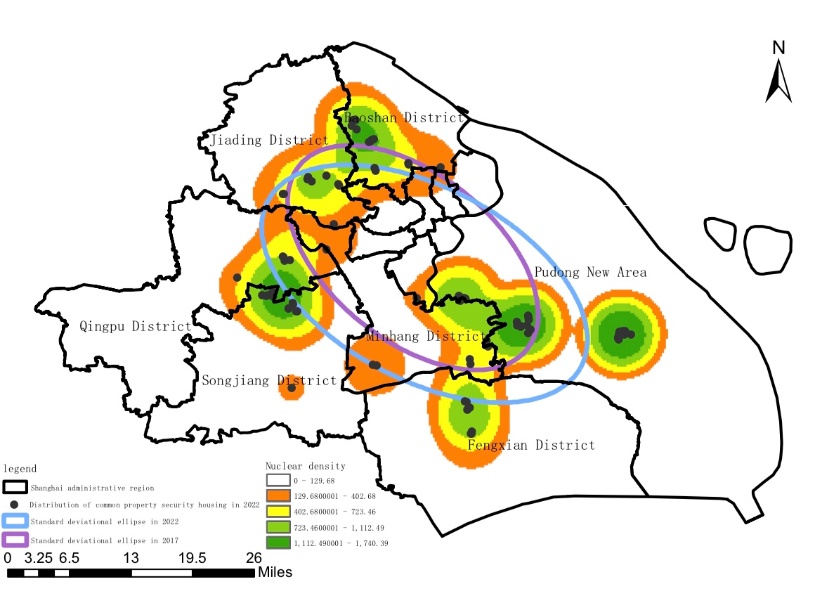
Figure 1: Spatial Distribution of Mutual Property Right Housing in Shanghai
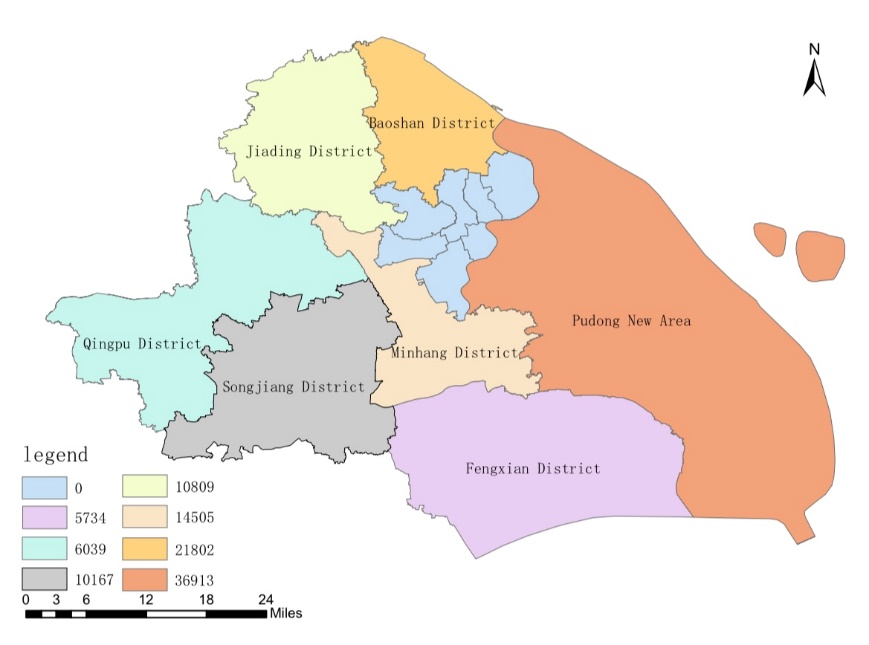
Figure 2: Number of Mutual Property Right Housing Units in Shanghai
4. Evaluation of the Spatial Suitability of Mutual Property Right Housing Layout in Shanghai
4.1. Evaluation Indicator System
4.1.1. Hierarchical Structure Model
The accessibility indicator system is divided into three levels: the objective level, the criterion level, and the indicator level, as illustrated in Figure 3. The objective level is the spatial accessibility of mutual property right housing in Shanghai. The criterion level comprises transportation accessibility, public service accessibility, and green space accessibility. Transportation accessibility includes two indicators: subway stations and bus stations, representing the convenience of residents' travel. Public service accessibility encompasses education facilities, medical facilities, commercial facilities, and cultural and sports facilities. This includes nine indicators: kindergartens, primary schools, middle schools, general hospitals, community hospitals, shopping centers, fair-price shops, cultural services, and sports venues. The distance from each facility indicates the convenience for residents to access various public facilities. Green space accessibility includes urban green parks and scenic spots above the city level, with distance representing the convenience for residents to access green resources.
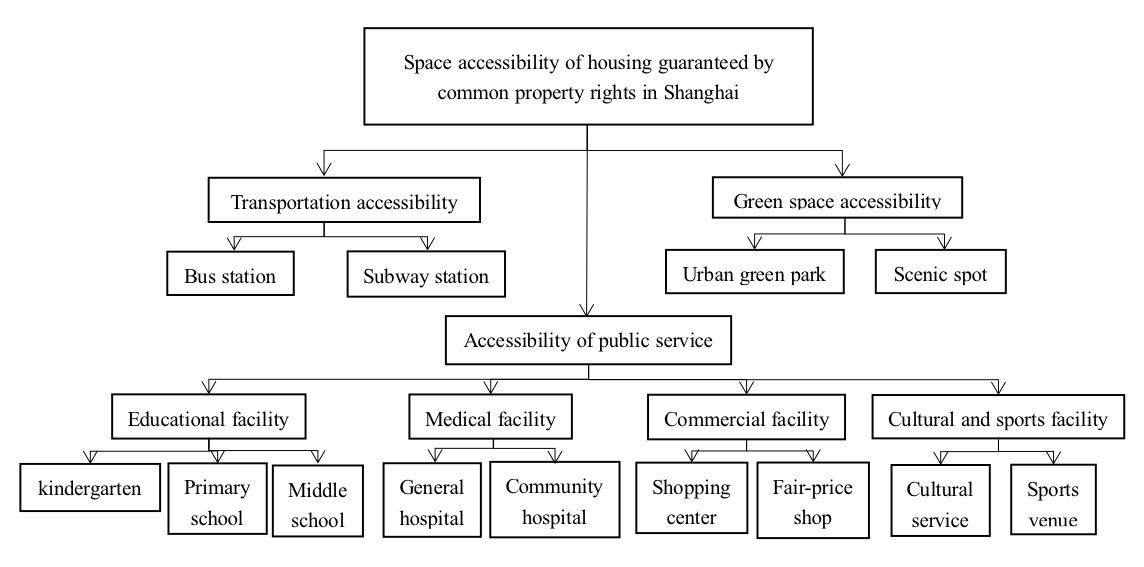
Figure 3: Hierarchical Structure Model of Spatial Accessibility of Mutual Property Right Housing in Shanghai
4.1.2. Accessibility Evaluation Indicators
For quantification purposes, each indicator is assigned five levels, corresponding to scores from 1 to 5. The scores are determined based on the shortest distance between mutual property right housing developments and each indicator. Through literature review and reference to the "Planning and Design Code for Residential Areas in Cities," considering the 5-minute living circle and 15-minute high-quality living circle, and integrating various modes of transportation such as walking, cycling, and public transit, specific scores are assigned for each indicator corresponding to specific service radii, as shown in Table 1.
Table 1: Accessibility Evaluation Indicator System for Spatial Distribution of Mutual Property Right Housing in Shanghai
Criterion Level | Indicator Level | Evaluation Indicator | Score | |||||
5 | 4 | 3 | 2 | 1 | ||||
Transportation Accessibility | Bus Station | Service Radius r/m | 0~ 250 | 251 ~500 | 501 ~750 | 751 ~ 1000 | 1001~ | |
Subway Station | Service Radius r/m | 0~500 | 501~ 1000 | 1001~ 1500 | 1501~ 2000 | 2001~ | ||
Public Service Accessibility | Educational Facility | Kindergarten | Service Radius r/m | 0~ 300 | 301 ~500 | 501 ~800 | 801 ~ 1000 | 1001~ |
Secondary School | Service Radius r/m | 0~500 | 501~ 1000 | 1001~ 1500 | 1501~ 2000 | 2001~ | ||
Primary School | Service Radius r/m | 0~500 | 501~ 1000 | 1001~ 1500 | 1501~ 2000 | 2001~ | ||
Medical Facility | General Hospital | Service Radius r/m | 0~500 | 501~ 1000 | 1001~ 1500 | 1501~ 2000 | 2001~ | |
Community Hospital | Service Radius r/m | 0~ 250 | 251 ~500 | 501 ~750 | 751 ~ 1000 | 1001~ | ||
Commercial Facility | Shopping Center | Service Radius r/m | 0~500 | 501~ 1000 | 1001~ 1500 | 1501~ 2000 | 2001~ | |
Fair-price Shop | Service Radius r/m | 0~ 250 | 251 ~500 | 501 ~750 | 751 ~ 1000 | 1001~ | ||
Cultural and Sports Facility | Cultural Service | Service Radius r/m | 0~ 250 | 251 ~500 | 501 ~750 | 751 ~ 1000 | 1001~ | |
Sports Venue | Service Radius r/m | 0~1000 | 1001~ 2000 | 2001~ 3000 | 3001~ 4000 | 4001~ | ||
Green Space Accessibility | Urban Green Park | Service Radius r/m | 0~500 | 501~ 1000 | 1001~ 1500 | 1501~ 2000 | 2001~ | |
Scenic Spots above City Level | Service Radius r/m | 0~1000 | 1001~ 2000 | 2001~ 3000 | 3001~ 4000 | 4001~ | ||
4.1.3. Determination of Weights for Each Indicator
In the Analytic Hierarchy Process (AHP), the key to obtaining weights for each indicator lies in constructing a rational judgment matrix. In this study, judgment matrices were derived from two sources. Firstly, preliminary importance rankings for each indicator were established through interviews with relevant government officials and mutual property right housing occupants [14]. Secondly, 13 experts were invited to complete questionnaires, providing initial weights on a scale of 1 to 9. A comprehensive judgment matrix was then determined. Finally, the AHP model was employed using Yaahp software to construct the judgment matrix, determining weights for each indicator. The consistency of the matrix was verified through consistency testing [15], as presented in Table 2.
Table 2: Weight of Evaluation Factors for Spatial Accessibility of Mutual Property Right Housing in Shanghai
Objective Level | Criterion Level | Indicator Level | Weight | ||
Shanghai's Mutual Property Right Housing Spatial Accessibility | Transportation Accessibility | Bus Station | 0.667 | 0.582 | |
Subway Station | 0.333 | ||||
Public Service Accessibility | Educational Facility | Kindergarten | 0.073 | 0.309 | |
Secondary School | 0.184 | ||||
Primary School | 0.165 | ||||
Medical Facility | General Hospital | 0.368 | |||
Community Hospital | 0.046 | ||||
Commercial Facility | Shopping Center | 0.080 | |||
Fair-price Shop | 0.021 | ||||
Cultural and Sports Facility | Cultural Service | 0.031 | |||
Sports Venue | 0.030 | ||||
Green Space Accessibility | Urban Green Park | 0.250 | 0.109 | ||
Scenic Spots above City Level | 0.750 | ||||
4.2. Evaluation Results of Layout Suitability for Mutual Property Right Housing in Shanghai
Based on the scores and weights of each indicator, the raster calculation function in ArcGIS was employed to obtain scores for each criterion level. According to the score results, the spatial accessibility of mutual property right housing in each community in Shanghai was categorized into five levels: Excellent, Good, Average, Poor, and Very Poor. Figures (a) through (d) in Figure 4 illustrate the results of transportation accessibility, public service accessibility, green space accessibility, and comprehensive evaluation, respectively.
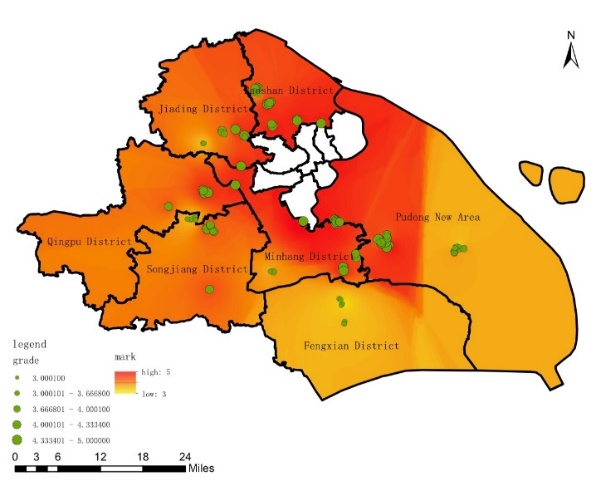

(a) Traffic (b) Public Facilities
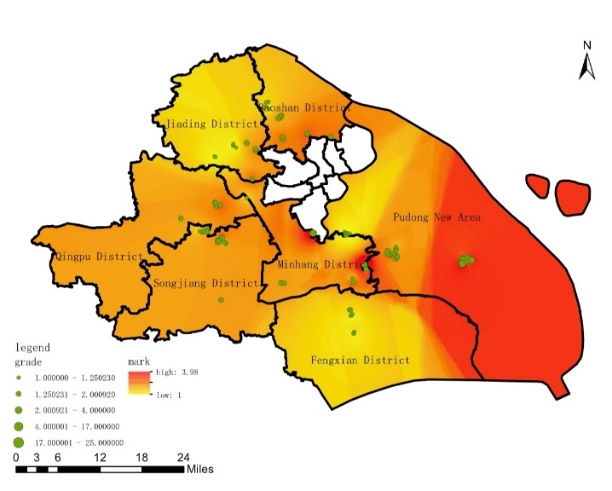
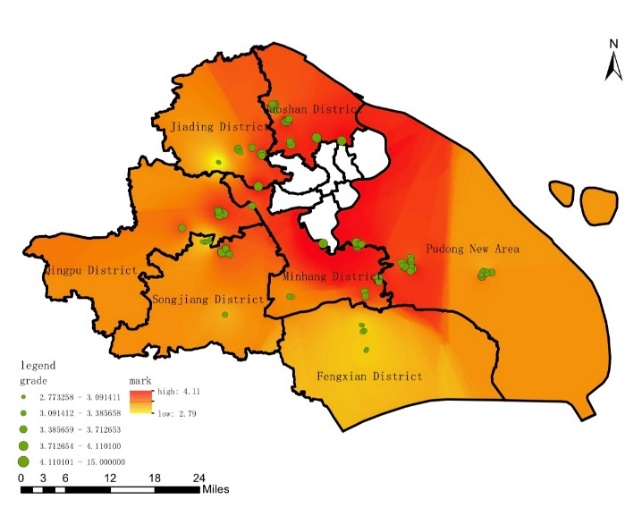
(c) Green Spaces (d) Comprehensive
Figure 4: Evaluation Results of Various Accessibility Aspects for Mutual Property Right Housing in Shanghai
4.2.1. Transportation Convenience
As of the end of 2022, Shanghai has a total of 1043 bus routes, with 20 subway lines in operation and 9 subway lines under construction. Based on the scoring, the transportation accessibility of mutual property right housing in Shanghai is divided into 5 levels: Very Poor (3.0), Poor (3.0~3.67), Average (3.67~4.0), Good (4.0~4.33), and Excellent (4.33~5.0). The proportions of each level are 2.27%, 28.41%, 1.14%, 12.50%, and 55.68%, respectively. The ranking of transportation accessibility for each district from highest to lowest is: Baoshan District, Qingpu District, Pudong New Area, Minhang District, Jiading District, Songjiang District, and Fengxian District. As depicted in Figure 4(a), mutual property right housing communities closer to the city center tend to have higher scores in transportation accessibility, while those farther away have lower scores. For instance, Baoshan District's Baoqiyayuan and Pudong New Area's Shengshinanyuan, both near the city center, scored the highest at 5.0. In contrast, all mutual property right housing in Fengxian District, situated far from the city center, received a lower transportation accessibility score of only 3.67, with an average distance of 3.3 km to the subway station. The community with the lowest score is Chunshuangyuan in Pudong New Area, scoring only 3.0. It can be observed that, except for a small proportion of communities in the Very Poor category, other levels are represented. Overall, approximately 56.98% of communities fall into the Good and Excellent categories. The spatial distribution of mutual property right housing in Shanghai demonstrates a moderate correlation with public transportation facilities and calls for further improvement.
4.2.2. Convenience of Public Facilities
Based on the scoring, the accessibility of public facilities for mutual property right housing in Shanghai is divided into 5 levels: Very Poor (1.50~1.88), Poor (1.88~2.54), Average (2.54~2.80), Good (2.80~3.06), and Excellent (3.06~3.40). The proportions of each level are 4.65%, 18.60%, 33.72%, 24.42%, and 16.28%, respectively. The ranking of public service accessibility for each district from highest to lowest is: Qingpu District, Pudong New Area, Minhang District, Baoshan District, Songjiang District, Jiading District, and Fengxian District. As shown in Figure 4(b), the overall score for public service accessibility is relatively low, with only communities around the city center receiving relatively high scores. The rest of the communities scored lower, all below 2.85, indicating a general level of public service accessibility. The community with the highest score for public service accessibility is Haitang Xinyuan in Qingpu District, scoring 3.84, while the lowest-scoring community is Xinzeyuan of Shenbeijiayuan in Songjiang District, scoring 1.65. In terms of specific public service accessibility, within 500 meters, the proportion of kindergartens is 41.86%, within 1000 meters, the proportion of primary and middle schools is 60.47% and 77.91%, respectively, showcasing a good correlation between mutual property right housing distribution and educational facilities. Medical services accessibility shows a concentric distribution, with accessibility decreasing from the central area outward. Most general hospitals are located beyond the regional accessible range of mutual property right housing. However, community hospitals, acting as the "last mile" of medical services, have relatively good accessibility. This suggests a general correlation between mutual property right housing distribution and medical facilities. The majority of large commercial centers are located at a considerable distance. Within a radius of 1000 meters, the proportion of shopping centers is 36.05%. The accessibility of fair-price shops and convenience stores is excellent, constituting 63.95% within a 500-meter radius. This indicates a favorable correlation between the distribution of affordable housing spaces and commercial facilities. The proportion of cultural venues within 500 meters is 24.42%, while sports facilities within 2000 meters account for 96.51%, demonstrating a good correlation between the distribution of affordable housing spaces and cultural and sports facilities. The overall accessibility of public facilities in the shared property assurance housing communities in Shanghai is relatively poor. Only 39.54% of the communities scored in the categories of good and excellent, highlighting the need for further measures to enhance accessibility.
4.2.3. Accessibility of Green Spaces
Based on the scoring, the accessibility of green spaces for mutual property right housing in Shanghai is divided into 5 levels: Very Poor (1.0), Poor (1.0~1.5), Average (1.5~2.0), Good (2.0~2.75), and Excellent (2.75~4.0). The proportions of each level are 29.07%, 10.47%, 41.86%, 16.28%, and 2.33%, respectively. The ranking of green space accessibility for each district from highest to lowest is: Songjiang District, Pudong New Area, Minhang District, Qingpu District, Jiading District, Baoshan District, and Fengxian District. As illustrated in Figure 4(c), mutual property right housing communities in suburban areas tend to have higher scores in green space accessibility, while those near the city center have lower scores, with the highest score reaching only 4.0. The community with the highest score for green space accessibility is Boyayuan in Minhang District, scoring 4.0, while there are 30 communities scoring the lowest at 1.0. Overall, the spatial distribution of mutual property right housing in Shanghai demonstrates a poor correlation with green spaces, with 74.41% of communities falling into the Very Poor and Poor categories, indicating a need for improvement.
5. Conclusions and Recommendations
5.1. Conclusions
5.1.1. Comprehensive Spatial Layout Suitability Analysis
Based on the scoring, the suitability of the comprehensive spatial distribution of mutual property right housing in Shanghai is divided into 5 levels: Very Poor (2.77~3.05), Poor (3.05~3.31), Average (3.31~3.57), Good (3.57~3.79), and Excellent (3.79~4.11). The proportions of each level are 16.28%, 18.60%, 18.60%, 26.74%, and 19.77%, respectively. The ranking of the overall spatial distribution suitability in various districts, from high to low, is as follows: Qingpu District, Minhang District, Baoshan District, Pudong New Area, Songjiang District, Jiading District, and Fengxian District. Among them, the relatively favorable areas are Qingpu, Minhang, Baoshan, and Pudong New Area, all scoring above 3.58. The suitability of spatial distribution is poorer in the remaining three districts. As shown in Figure 4(d), the distribution of overall spatial accessibility of shared property assurance housing in Shanghai is similar to the distribution of transportation accessibility. The closer to the city center, the better the overall spatial accessibility. The community with the highest score in overall spatial accessibility is Haixinxuan Yuan in Qingpu District, with a score of 4.12. The communities with the lowest score are Jiangxin Yuelu and Mingchan Bieju in Jiading District, scoring 2.83. In conclusion, the overall suitability of spatial distribution in shared property assurance housing communities in Shanghai is generally moderate, with only 46.51% of communities rated as excellent or good. This aspect needs attention when selecting new locations for shared property assurance housing.
5.1.2. Spatial Autocorrelation Analysis
For the suitability scores, a local Moran's I analysis was conducted to identify areas of low/low aggregation, representing regions with significant characteristics of low scores aggregation [15]. The concentrated low/low aggregation areas are mainly at the junction of Fengxian District, Qingpu District, and Songjiang District, the central region of Pudong New Area, and the southwest part of Jiading District. These are areas that require particular attention for future adjustments to urban spatial structures and the construction of public service facilities.
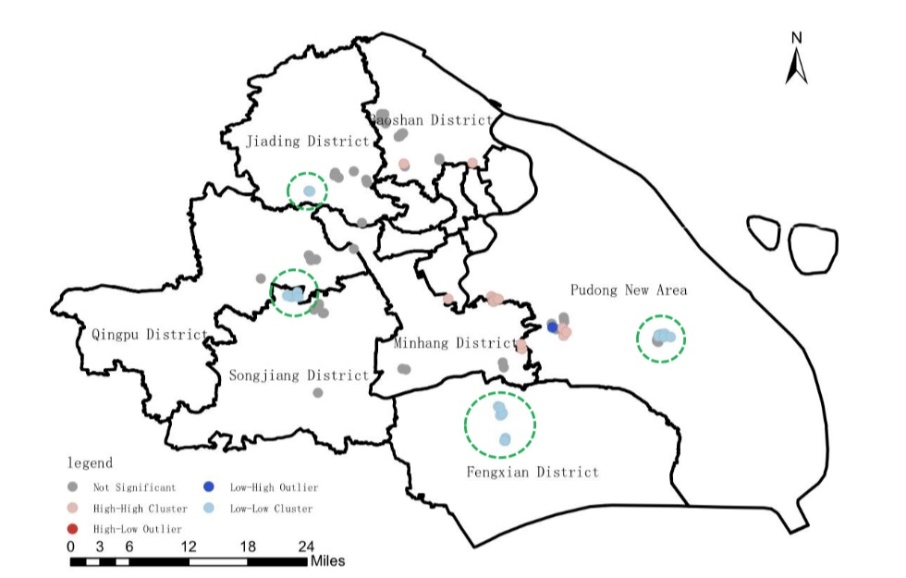
Figure 5: Local Moran's I Analysis Chart
5.2. Recommendations
To facilitate the better development of mutual property right housing in Shanghai, this paper proposes recommendations in the direction of optimizing spatial layout:
(1) Adopting a Mixed Development Model
In China, the selection of locations for mutual property right housing is mostly concentrated in areas outside the central urban districts. However, the construction practices in developed countries indicate that this concentration may lead to spatial deprivation for low-income groups, exacerbating wealth disparities and intensifying social conflicts [16]. Therefore, it is suggested to reduce large-scale centralized construction of affordable housing. Instead, a proportionate (e.g., 10%-20%) allocation of mutual property right housing within regular residential areas could be implemented. Simultaneously, in accordance with existing policies, incentives such as reducing land transfer fees in proportion to the built area could be introduced for mutual property right housing [17]. This approach encourages a relatively mixed layout of various types, levels, and groups of housing, promoting residential integration across different social strata [18]. A mixed living model allows residents from different income groups to more fairly enjoy various public services in the city. Moreover, residents from low-income groups are more likely to gain additional social capital, reducing social distance and addressing issues of self-isolation [19].
(2) Strengthening Public Transport-Led Residential Area Models
Individuals with middle to low incomes have a strong demand for accessibility to subway stations within one kilometer. When planning and constructing mutual property right housing, priority should be given to areas within one kilometer of subway stations. Additionally, utilizing short-distance shuttle services connecting mutual property right housing and subway stations along subway lines can help expand coverage. For completed affordable housing, enhancing the density of surrounding bus routes and stops is crucial. For instance, increasing the frequency of existing bus routes during peak hours, improving transfer facilities between rail transport modes, and enhancing the supporting public transport system should be considered.
(3) Improving the Construction of Public Service Facilities
Field research results indicate that there is a significant demand among low-income groups for public facilities such as education and healthcare. Therefore, mutual property right housing should be prioritized in areas with convenient transportation and relatively complete public service facilities. This strategy aims to enhance the satisfaction of the targeted beneficiaries and, to some extent, reduce the construction costs of government-built public facilities. Additionally, a comprehensive plan should be implemented for urban green parks and green spaces. The number of parks should be increased appropriately, especially in areas with poor accessibility, community parks could be added. Leveraging existing land resources, the transformation of brownfield sites for the construction of public green spaces should be maximized. Simultaneously, the existing green spaces should be expanded and renovated, aiming to achieve feasible goals while reducing costs and improving efficiency.
References
[1]. Zheng, J. Y. (2021). Research on the Benefit Evaluation of Mutual Property Right Housing from the Government's Perspective [Doctoral dissertation, Harbin Institute of Technology].
[2]. Song, M. X. (2017). Research on the Development Process and Design Strategies of Affordable Housing Based on Urban Correlation [Doctoral dissertation, Hunan University].
[3]. Zhou, Z. J. (2023). Research on the Improvement of Entry and Exit Mechanism of Mutual Property Right Housing [Doctoral dissertation, Hubei University].
[4]. Holloway, S. R., Bryan, D., Chabot, R., et al. (1998). Exploring the effect of public housing on the concentration of poverty in Columbus, Ohio. Urban Affairs Review, 33(6), 767-789.
[5]. Atkinson, R., Kintrea, K. (2001). Disentangling area effects: evidence from deprived and non-deprived neighbourhoods. Urban studies, 38(12), 2277-2298.
[6]. Teitz, M. B. (1968). Toward a theory of urban public facility location. In Papers of the Regional Science Association, 35-51.
[7]. Welch, T. F. (2013). Equity in transport: The distribution of transit access and connectivity among affordable housing units. Transport policy, 30, 283-293.
[8]. Zhong, Q., Karner, A., Kuby, M., et al. (2019). A multiobjective optimization model for locating affordable housing investments while maximizing accessibility to jobs by public transportation. Environment and Planning B: Urban Analytics and City Science, 46(3), 490-510.
[9]. Ihlanfeldt, K., Mayock, T. (2019). Affordable housing and the socioeconomic integration of elementary schools. The Journal of Real Estate Finance and Economics, 58, 567-595.
[10]. Zheng, S. Q., Zhang, Y. J. (2010). Spatial selection of affordable housing: Theoretical basis, international experience, and Chinese reality. Modern Urban Research, 25(09), 18-22.
[11]. Dang, Y., Liu, Z., Zhang, W. (2014). Land-based interests and the spatial distribution of affordable housing development: The case of Beijing, China. Habitat International, 44, 137-145.
[12]. Zhu, W. J., Deng, Y. Y., Li, X. X. (2023). Discussion on the spatial layout of affordable housing under rail transit travel: Based on observations in Shenzhen. Urban Planning, 47(03), 85-96.
[13]. Zhang, Z., Li, J. F., Liu, Y. Z., et al. (2008). Urban residential space differentiation and social equity under the operation mechanism of affordable housing: A case study of Wuhan. China Soft Science, (10), 37-43.
[14]. Gong, Y., Xuan, L. Y., Sun, S., et al. (2020). Research on the spatial accessibility of public facilities in public rental housing: A case study of Shenzhen. Journal of Peking University (Natural Science Edition), 56(06), 1113-1121.
[15]. Li, Y., Xia, Y. L., Cui, X. P., et al. (2021). Evaluation of spatial distribution suitability of Xi'an affordable housing from a low-carbon perspective. Huazhong Architecture, 39(06), 80-84.
[16]. Ru, Y. L., Li, L., Li, G. C. (2016). Research on the optimization of living space for public rental housing in Hangzhou under the perspective of spatial justice. Urban Development Research, 23(04), 107-117.
[17]. Jiao, Y. X. (2007). Discussion on the mixed construction mode of affordable housing to promote residential harmony. Urban Development Research, 80(05), 57-61.
[18]. Guo, D., Li, J., Wang, Z. (2011). Research on the characteristics and optimization strategies of spatial layout of affordable housing in Nanjing. Modern Urban Research, 26(03), 83-88.
[19]. Tian, Y., Li, D. X., Bi, X. Y. (2006). Analysis of mixed residence of residents at different levels and its feasibility. Architectural Journal, (04), 36-39.
Cite this article
Ding,M.;Zhang,X.;Wu,X. (2024). A Study on Spatial Accessibility and Distribution Suitability of Mutual Property Right Housing in Shanghai. Lecture Notes in Education Psychology and Public Media,41,58-69.
Data availability
The datasets used and/or analyzed during the current study will be available from the authors upon reasonable request.
Disclaimer/Publisher's Note
The statements, opinions and data contained in all publications are solely those of the individual author(s) and contributor(s) and not of EWA Publishing and/or the editor(s). EWA Publishing and/or the editor(s) disclaim responsibility for any injury to people or property resulting from any ideas, methods, instructions or products referred to in the content.
About volume
Volume title: Proceedings of the 2nd International Conference on Social Psychology and Humanity Studies
© 2024 by the author(s). Licensee EWA Publishing, Oxford, UK. This article is an open access article distributed under the terms and
conditions of the Creative Commons Attribution (CC BY) license. Authors who
publish this series agree to the following terms:
1. Authors retain copyright and grant the series right of first publication with the work simultaneously licensed under a Creative Commons
Attribution License that allows others to share the work with an acknowledgment of the work's authorship and initial publication in this
series.
2. Authors are able to enter into separate, additional contractual arrangements for the non-exclusive distribution of the series's published
version of the work (e.g., post it to an institutional repository or publish it in a book), with an acknowledgment of its initial
publication in this series.
3. Authors are permitted and encouraged to post their work online (e.g., in institutional repositories or on their website) prior to and
during the submission process, as it can lead to productive exchanges, as well as earlier and greater citation of published work (See
Open access policy for details).
References
[1]. Zheng, J. Y. (2021). Research on the Benefit Evaluation of Mutual Property Right Housing from the Government's Perspective [Doctoral dissertation, Harbin Institute of Technology].
[2]. Song, M. X. (2017). Research on the Development Process and Design Strategies of Affordable Housing Based on Urban Correlation [Doctoral dissertation, Hunan University].
[3]. Zhou, Z. J. (2023). Research on the Improvement of Entry and Exit Mechanism of Mutual Property Right Housing [Doctoral dissertation, Hubei University].
[4]. Holloway, S. R., Bryan, D., Chabot, R., et al. (1998). Exploring the effect of public housing on the concentration of poverty in Columbus, Ohio. Urban Affairs Review, 33(6), 767-789.
[5]. Atkinson, R., Kintrea, K. (2001). Disentangling area effects: evidence from deprived and non-deprived neighbourhoods. Urban studies, 38(12), 2277-2298.
[6]. Teitz, M. B. (1968). Toward a theory of urban public facility location. In Papers of the Regional Science Association, 35-51.
[7]. Welch, T. F. (2013). Equity in transport: The distribution of transit access and connectivity among affordable housing units. Transport policy, 30, 283-293.
[8]. Zhong, Q., Karner, A., Kuby, M., et al. (2019). A multiobjective optimization model for locating affordable housing investments while maximizing accessibility to jobs by public transportation. Environment and Planning B: Urban Analytics and City Science, 46(3), 490-510.
[9]. Ihlanfeldt, K., Mayock, T. (2019). Affordable housing and the socioeconomic integration of elementary schools. The Journal of Real Estate Finance and Economics, 58, 567-595.
[10]. Zheng, S. Q., Zhang, Y. J. (2010). Spatial selection of affordable housing: Theoretical basis, international experience, and Chinese reality. Modern Urban Research, 25(09), 18-22.
[11]. Dang, Y., Liu, Z., Zhang, W. (2014). Land-based interests and the spatial distribution of affordable housing development: The case of Beijing, China. Habitat International, 44, 137-145.
[12]. Zhu, W. J., Deng, Y. Y., Li, X. X. (2023). Discussion on the spatial layout of affordable housing under rail transit travel: Based on observations in Shenzhen. Urban Planning, 47(03), 85-96.
[13]. Zhang, Z., Li, J. F., Liu, Y. Z., et al. (2008). Urban residential space differentiation and social equity under the operation mechanism of affordable housing: A case study of Wuhan. China Soft Science, (10), 37-43.
[14]. Gong, Y., Xuan, L. Y., Sun, S., et al. (2020). Research on the spatial accessibility of public facilities in public rental housing: A case study of Shenzhen. Journal of Peking University (Natural Science Edition), 56(06), 1113-1121.
[15]. Li, Y., Xia, Y. L., Cui, X. P., et al. (2021). Evaluation of spatial distribution suitability of Xi'an affordable housing from a low-carbon perspective. Huazhong Architecture, 39(06), 80-84.
[16]. Ru, Y. L., Li, L., Li, G. C. (2016). Research on the optimization of living space for public rental housing in Hangzhou under the perspective of spatial justice. Urban Development Research, 23(04), 107-117.
[17]. Jiao, Y. X. (2007). Discussion on the mixed construction mode of affordable housing to promote residential harmony. Urban Development Research, 80(05), 57-61.
[18]. Guo, D., Li, J., Wang, Z. (2011). Research on the characteristics and optimization strategies of spatial layout of affordable housing in Nanjing. Modern Urban Research, 26(03), 83-88.
[19]. Tian, Y., Li, D. X., Bi, X. Y. (2006). Analysis of mixed residence of residents at different levels and its feasibility. Architectural Journal, (04), 36-39.





